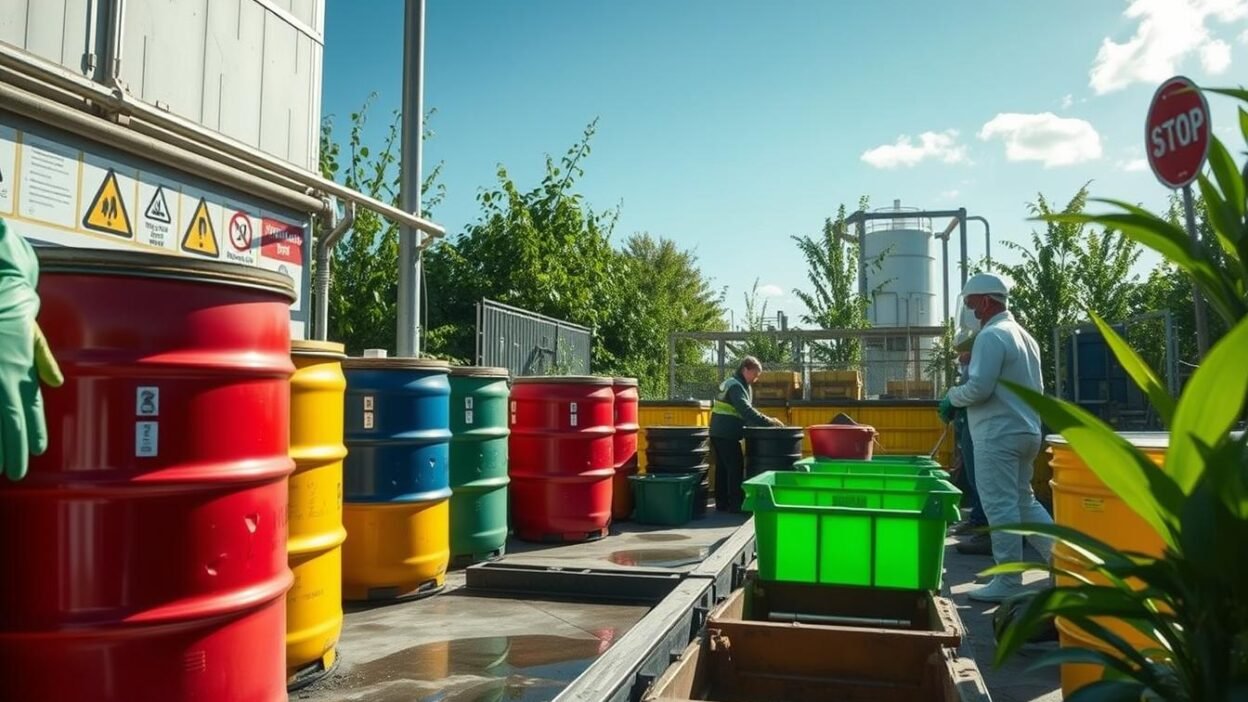The U.S. Environmental Protection Agency (EPA) has identified over 450 listed hazardous wastes. This highlights the complexity of managing hazardous waste in our modern world. These materials can harm human health and the environment if not handled properly.
Hazardous waste management involves collecting, treating, transporting, and disposing of harmful substances. The EPA defines hazardous waste as materials that can cause substantial harm to humans and their surroundings. This definition guides the regulatory framework for protecting public health and ecosystems.
Preparing for the UGC NET exam can be a daunting task, but with the right resources, candidates can navigate the process effectively. Websites like MyJRF provide a comprehensive platform for aspiring educators, offering specialized guidance for UGC NET Paper 2 preparation and essential tips for acing UGC NET Paper 1. Additionally, understanding the revised syllabus provided by UGC is crucial for a targeted study approach. For official announcements and updates, candidates should regularly visit the UGC NET NTA portal, while the UGC’s job section and the main UGC website are invaluable for post-exam opportunities and academic resources. With these tools, candidates can maximize their preparation and set themselves up for success. Preparing for Paper 1 and UGC NET Paper 2 Education requires a strategic approach with quality resources. UGC NET Education aspirants can access structured video lectures that cover essential concepts comprehensively. For an in-depth understanding, check out teaching aptitude videos and research aptitude guidance to strengthen your foundation. Additionally, higher education system topics and communication skills preparation are crucial for scoring high. Explore logical reasoning tutorials and mathematical reasoning lectures for better problem-solving skills. Enhance your exam strategy with people, development & environment lessons and ICT in education modules. For previous year papers and practice sessions, explore mock test videos and exam strategy tips. Stay ahead in your preparation with teaching methodology insights and subscribe to Educators Plus for expert guidance.
In India, hazardous waste management is a pressing challenge due to rapid industrialization and urbanization. Effective pollution prevention and waste minimization strategies are crucial. Various sectors must follow complex regulations to handle hazardous materials properly.
This article explores key aspects of hazardous waste management. We’ll examine regulations, best practices, and innovative approaches to reduce environmental impact. Understanding these elements helps create a safer, cleaner future for everyone.
Key Takeaways
- The EPA recognizes over 450 listed hazardous wastes
- Proper labeling and documentation are essential for hazardous waste containers
- Generators must follow a three-step determination process for waste classification
- “Cradle to grave” responsibility applies to hazardous waste management
- Electronic manifests (e-Manifests) are becoming increasingly common for tracking
- Regular audits and inventory checks are crucial for effective management
- Emergency response planning is a critical component of hazardous waste handling
Understanding Hazardous Waste Management
Hazardous waste management is vital for environmental compliance. It covers handling, treating, and disposing of risky materials. The EPA groups hazardous waste into four types: ignitable, corrosive, reactive, and toxic.
Definition and Scope
Hazardous waste includes various dangerous materials. These can be liquids, solids, or gases. Businesses must identify if their waste is hazardous.
This classification is key for proper treatment and recycling. It ensures safe handling of potentially harmful substances.
Environmental Impact
Mismanaging hazardous waste has serious consequences. Globally, 6% of hazardous waste is improperly handled. This leads to environmental and health risks.
In the U.S., 84% of contaminated sites link to poor waste management. This shows why following waste protocols is crucial.
Regulatory Framework Overview
Hazardous waste regulations are complex and strict. A Tacoma waste company paid $2.2 million for compliance violations.
An electric vehicle company faced $31,000 in penalties in California. These cases show the high cost of non-compliance.
They highlight the need for strong waste management strategies. Proper handling is essential for both safety and financial reasons.
| Waste Type | Percentage | Key Characteristic |
|---|---|---|
| Toxic | 50% | Often carcinogenic and mutagenic |
| Ignitable | 20% | Burns below 140°F (60°C) |
| Reactive | 15% | Significant explosion risks |
| Corrosive | 10% | Includes strong acids and bases |
| Infectious | 5% | Primarily from healthcare industry |
Types of Hazardous Waste Materials
Hazardous waste materials are risky for human health and the environment. They need special handling to prevent contamination. The EPA groups these wastes into four main types.
Ignitable Waste Substances
Ignitable waste can easily catch fire or explode. Used kerosene, gasoline, and petroleum solvents are examples. The EPA defines ignitable waste as having a flashpoint below 140°F (60°C).
High-temperature incineration, up to 2,192°F (1,200°C), safely breaks down these hazardous substances.
Corrosive Materials
Corrosive waste is highly acidic or alkaline. It can erode containers and release harmful substances. Lead-acid batteries and caustic cleaning solutions are common examples.
Proper containment prevents leaching in hazmat landfills.
Reactive Waste Types
Reactive waste can explode or release toxic gases. This happens when exposed to air, water, or other substances. Pressurized aerosol cans and lithium-sulfur batteries are in this category.
These materials need special handling and disposal for safety.
Toxic Substances
Toxic waste can pollute groundwater and harm living things. The EPA uses a special test to check toxicity levels. Electronics batteries and painting waste often contain toxic materials.
In 2017, 1.5 tons of hazardous waste were recycled. This shows the importance of proper disposal.
Knowing these waste types is key for good management. Modern hazardous waste landfills cost over $1 million per acre to build. This highlights the need for waste reduction and safe disposal.
Legal Requirements and Compliance Standards
India enforces strict rules for hazardous waste management. The 2016 Hazardous and Other Wastes Rules guide proper handling of dangerous materials. These regulations ensure environmental safety and proper waste treatment.
Businesses must get authorization from the State Pollution Control Board. This permit lasts five years and needs renewal three months before expiry. Companies can store hazardous waste for up to 90 days.
Yearly reporting is required by June 30th. Companies must submit detailed records of their hazardous waste activities. This helps authorities track environmental compliance across industries.
The rules stress waste reduction and safe disposal. Companies should prevent, minimize, reuse, and recycle hazardous materials when possible. Proper treatment is crucial for unavoidable waste.
India bans importing hazardous waste for disposal. However, it allows imports for recycling or reuse under strict oversight. The Ministry of Environment regulates these movements.
Breaking these rules can lead to hefty fines. Penalties range from ₹1,000 to over ₹50,000, based on severity. To avoid costs, businesses should invest in training and advanced waste management tech.
Waste Classification and Identification Procedures
Proper waste classification is vital for hazardous waste management. It’s the basis for effective pollution prevention strategies. Indian regulations govern the handling of various waste types, including hazardous materials.
Waste Determination Methods
Waste generators must accurately determine their waste’s nature. This involves lab testing and process knowledge. The EPA classifies hazardous waste into four main categories: F, K, P, and U.
Each category has specific criteria. These criteria impact waste management strategies.
Classification Guidelines
Hazardous waste is identified by specific traits. These include ignitability, corrosivity, reactivity, and toxicity. Ignitable waste has a flash point below 60°C.
Corrosive waste has a pH of 2.0 or less, or 12.5 or greater. The TCLP test finds heavy metals and pesticides in waste.
Documentation Requirements
Proper documentation is key for hazmat regulation compliance. Generators must keep records of waste characterization, quantity, and disposal methods.
India’s 2016 rules govern different waste types. These include plastic, e-waste, bio-medical, and hazardous waste. Each category has specific documentation requirements.
“Waste characterization is essential as it helps determine the composition of waste streams, which is critical for effective waste treatment.”
Following these steps helps optimize hazardous waste management. It reduces environmental risks and ensures compliance with regulations.
Storage and Containment Guidelines
Safe hazardous waste management relies on proper storage and containment. These guidelines ensure environmental compliance and industrial safety. They also help minimize risks associated with dangerous materials.
Storage Facility Requirements
Hazardous waste storage facilities must meet specific standards. They need proper ventilation, temperature control, and restricted access. These facilities should prevent leaks, spills, and accidental releases.
Regular inspections are necessary to maintain compliance with regulations. This ensures the ongoing safety and effectiveness of the storage facility.
Container Management
Safe hazardous waste storage depends on effective container management. Use sealed, compatible containers that stay closed except when adding waste. Fill containers to 95% capacity to allow for temperature changes.
Label all containers clearly with proper tags. Include accumulation start dates on these labels for accurate tracking.
Safety Protocols
Safety is crucial in hazardous waste storage areas. Implement strict protocols to protect workers and the environment.
- Segregating incompatible wastes
- Using secondary containment trays
- Providing easy access for inspections
- Maintaining clean storage areas
- Training staff in proper handling techniques
These guidelines help organizations maintain environmental compliance. They also ensure industrial safety in hazardous waste management. Following these rules protects both people and the planet.
| State | Present Hazardous Waste Generation (TPA) | Current Incinerator Capacity (TPA) | Proposed Incinerator Capacity (TPA) |
|---|---|---|---|
| Gujarat | 106,000 | 32,600 | 201,608 |
| Andhra Pradesh | 31,700 | 20,000 | 31,000 |
| Maharashtra | 152,000 | 30,000 | 78,500 |
| West Bengal | 13,055 | 10,800 | 17,800 |
| Tamil Nadu | 11,500 | N/A | 11,500 |
Transportation and Handling Protocols
Hazardous waste management needs strict transportation and handling rules. India produced 7.46 million metric tonnes of hazardous waste in 2015. These protocols ensure environmental safety and compliance.
Hazmat transport requires special vehicles and containers. Tank trucks can hold up to 34,000 litres. For smaller amounts, 200-litre drums are used. Certified transporters must follow safety rules to avoid accidents.
The manifest system is vital in hazardous waste management. It tracks waste from creation to disposal. All parties must sign these documents for accountability. This system has helped reduce illegal dumping.
| Aspect | Data |
|---|---|
| Facility Compliance Rate | 80% |
| Transportation Incidents | 15% of shipments |
| Non-Compliance Penalty | $45,000 average |
| Employee Training Compliance | 70% |
About 44,000 industries in India create hazardous waste. The Hazardous Waste rules, started in 1989, govern these practices. These rules have been updated several times since then.
The regulations require proper handling, storage, and transport of hazardous materials. This helps reduce environmental impact and protect public safety.
Treatment Technologies and Methods
Waste treatment is vital for managing hazardous materials. It uses various technologies to reduce harmful effects. These methods also promote recycling and safer waste handling.
Physical Treatment Options
Physical treatments use mechanical processes to change waste properties. Filtration removes solid particles from liquids. Centrifugation separates materials based on density.
Solidification turns liquid waste into a solid form. This makes the waste safer to handle and transport.
Chemical Treatment Processes
Chemical treatments alter waste composition to make it less dangerous. Neutralization balances acidic or alkaline waste. Oxidation breaks down organic compounds.
Reduction changes the chemical state of metals. These methods help prevent pollution and protect the environment.
Biological Treatment Solutions
Biological treatments use living organisms to break down waste. Bioremediation employs microbes to degrade contaminants. Composting turns organic waste into useful soil.
These eco-friendly methods support recycling efforts. They help reduce waste and create valuable products.
Advanced technologies like plasma arc treatment operate at extreme temperatures. They can degrade hazardous materials more effectively. This shows ongoing innovation in waste treatment.
As regulations change, new methods emerge. These tackle the challenges of hazardous waste management. They aim to protect both people and the environment.
| Treatment Type | Example | Benefit |
|---|---|---|
| Physical | Filtration | Removes solids from liquids |
| Chemical | Neutralization | Balances pH levels |
| Biological | Bioremediation | Uses microbes to degrade waste |
Proper Labeling and Documentation Systems
Precise labeling and documentation are crucial for managing hazardous waste effectively. These systems ensure environmental compliance and industrial safety. Proper labeling guarantees safe handling, storage, and disposal of dangerous materials.
Labels must include key information:
- Clear “Hazardous Waste” marking
- Accumulation start date
- Waste composition and physical state
- Hazard properties (flammable, reactive, corrosive)
- Generator’s name and address
Documentation requirements vary based on generator status:
| Generator Type | Monthly Generation Limit | On-site Accumulation Limit |
|---|---|---|
| Very Small Quantity | Up to 100 kg | 1,000 kg |
| Small Quantity | 100-1,000 kg | 6,000 kg |
| Large Quantity | 1,000 kg or more | 90-day storage max |
Strong documentation systems improve record-keeping and ensure regulatory compliance. Important records include waste manifests, shipping documents, and treatment certificates. Electronic systems make tracking easier and simplify audits.
Staff training is vital for effective labeling and documentation. Regular sessions help reduce errors and maintain accurate waste tracking. This approach supports environmental protection and workplace safety standards.
Emergency Response and Contingency Planning
Hazardous waste management needs strong emergency response plans. These plans protect people and the environment. Quick actions during accidents can reduce risks significantly.
Emergency Procedures
Safety protocols are crucial for hazardous waste management. At Florida International University, the Environmental Health & Safety Department oversees these operations. Their Central Accumulation Area stores various hazardous materials.
This 156 square foot area houses acutely toxic, oxidizing, corrosive, flammable, and reactive substances. Proper handling of these materials is essential for safety.
Spill Management
Effective spill management is key in handling hazardous waste. Chemical spills over 2.5 liters need emergency response. Spill kits are essential tools.
These kits typically include:
- Tyvek chemical resistance coveralls
- Safety goggles
- Nitrile/neoprene gloves
- Clay absorbent materials
- Acid/base absorbent socks, pillows, and mats
Evacuation Protocols
Clear evacuation plans are vital for industrial safety. In emergencies, people must move about 200 feet away from the building. The University of Chicago Police Department helps with evacuations.
They also notify on-call safety officers. Working with local fire departments and hazmat teams is crucial.
Good emergency plans show commitment to safe waste management. Regular drills and training keep staff ready. This approach improves overall industrial safety.
Staff Training and Safety Measures
Proper staff training is crucial for hazardous waste management. It ensures employees understand risks and handle materials safely. Industrial safety and environmental compliance are top priorities in this field.
OSHA sets specific training requirements for hazardous waste management. Employees must finish training within six months of starting work. They can’t work alone until training is complete.
Annual reviews of initial training are mandatory. Keeping accurate records is essential for compliance and safety.
Facilities must keep training records for each employee. Current personnel records stay until the facility closes. For former workers, records are kept for three years after leaving.
Personal Protective Equipment (PPE) is key to worker safety. The type of PPE needed depends on the hazardous material. Some jobs need only gloves and safety glasses.
Other situations may require full hazmat suits and respirators. Proper PPE selection is vital for worker protection.
| Training Aspect | Requirement |
|---|---|
| Completion Timeline | Within 6 months of employment |
| Annual Review | At least once per calendar year |
| Record Retention (Current Employees) | Until facility closure |
| Record Retention (Former Employees) | 3 years from last work date |
Emergency preparedness is a critical part of training. Employees should know where to find eyewash stations and spill cleanup materials. They must also learn evacuation procedures.
Regular drills help reinforce this knowledge. They also improve response times during real emergencies. Being prepared can save lives and prevent injuries.
Waste Minimization Strategies
Waste minimization strategies are vital for reducing hazardous waste and its environmental impact. India’s rapid industrialization has increased waste production. Implementing these strategies is now more crucial than ever.
Source Reduction
Source reduction prevents waste at its origin. It involves changing production processes and improving inventory management. The dry cleaning industry has switched to less toxic alternatives, reducing hazardous waste.
Small businesses can help by properly disposing of solvents, paints, and electronic waste. These items often contain toxic properties that need careful handling.
Recycling Programs
Recycling is key to waste minimization. In 2009, composting diverted 82 million tons of waste from landfills. This prevented the release of 178 million metric tons of carbon dioxide.
Effective collection and processing systems are crucial for successful recycling. Businesses can recycle paper, plastics, and metals. This conserves resources and reduces energy use.
Resource Recovery
Resource recovery extracts valuable materials from waste streams. Anaerobic digestion produces biogas for heating and electricity generation. Metal finishing processes can recover copper and nickel.
Food-based oils can be turned into biodiesel. These practices minimize waste and create potential revenue. This shows that pollution prevention can be economically beneficial.
FAQ
What is hazardous waste management?
Hazardous waste management is a systematic approach to handle dangerous materials. It involves treating, storing, and disposing of substances that risk human health or the environment. This process uses various practices to minimize harm and ensure regulatory compliance.
How is hazardous waste classified?
Hazardous waste falls into four main categories: ignitable, corrosive, reactive, and toxic. Classification depends on specific characteristics defined by regulatory agencies. It often requires laboratory testing or process knowledge to determine the category.
What are some common examples of hazardous waste?
Common hazardous waste includes used batteries, solvents, pesticides, and mercury-containing equipment. Certain paints, dyes, and pharmaceutical waste also fall into this category. These materials can come from manufacturing, laboratories, healthcare facilities, and households.
What are the key regulations governing hazardous waste management?
Key regulations vary by country but often include comprehensive frameworks. In the United States, the Resource Conservation and Recovery Act (RCRA) is a major regulation. These rules typically cover waste identification, handling, transportation, treatment, and disposal.
International agreements like the Basel Convention also regulate hazardous waste movement across borders.
How should hazardous waste be stored safely?
Safe storage requires proper containment in compatible, labeled containers. Incompatible materials should be segregated, and regular inspections must be conducted. Storage areas need impermeable surfaces, secondary containment systems, and emergency response equipment.
Adequate ventilation, temperature control, and restricted access are also crucial. Compliance with specific regulatory requirements for storage time limits is essential.
What are some effective waste minimization strategies?
Effective strategies include modifying production processes and using alternative raw materials. Implementing recycling programs and improving inventory management can reduce expired materials. Resource recovery, extracting valuable components from waste streams, is another useful approach.
Regular waste audits and employee training on reduction practices are important. These elements form a comprehensive minimization strategy.
How is hazardous waste transported safely?
Safe transportation uses certified transporters and proper packaging and labeling of materials. Loads must be secured to prevent spills or leaks. Designated routes should be followed, and accurate documentation maintained.
Drivers need training in emergency procedures. Vehicles must meet specific safety standards. Compliance with regulations like the Department of Transportation’s Hazardous Materials Regulations is crucial.
What treatment methods are used for hazardous waste?
Treatment methods include physical processes like filtration or solidification. Chemical treatments such as neutralization or oxidation are also used. Biological treatments like bioremediation and thermal treatments including incineration are common.
Advanced technologies like plasma arc treatment are emerging. The choice depends on waste type, regulations, and environmental factors.
What should an emergency response plan for hazardous waste incidents include?
An effective plan needs clear procedures for various incident types. It should outline response team roles, evacuation protocols, and communication systems. Personal protective equipment requirements and cleanup procedures are crucial.
Regular drills and training exercises ensure preparedness. The plan should detail coordination with local emergency services. It must also include regulatory notification procedures.
How can companies ensure proper staff training for hazardous waste management?
Companies should develop comprehensive programs covering waste identification and handling procedures. Training must include personal protective equipment use and emergency response. It should be role-specific, regularly updated, and include practical components.
Maintaining detailed training records is important. Periodic assessments help ensure effectiveness. Fostering a culture of safety and environmental responsibility is crucial.





